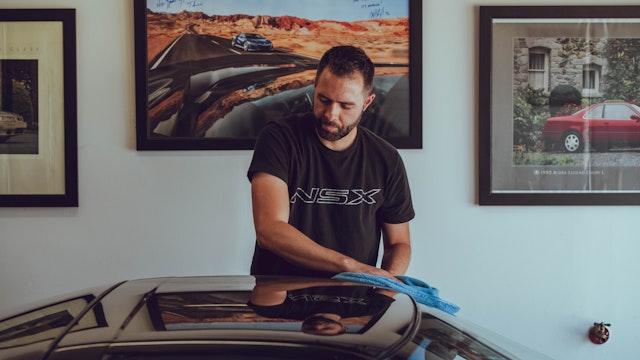How To Maintain Your Classic Car - The Basics

Owners of classic cars know that buying (and insuring) your vehicle is only the first step of ownership. No matter what kind of vehicle you’ve chosen to invest in, it’s going to need maintenance, upkeep and care to maintain its value and appearance. The good news is that this doesn’t need to be a tedious task-- just a little bit of time each month can go a long way towards keeping your classic car in tip-top shape.
Stains happen. Spills happen. Assuming you’re enjoying the drive, small scratches, nicks, tears and scrapes are a natural part of a car’s lifespan. - If your vehicle lives mostly in the garage, you’ll need a lot less maintenance. If that’s the case, don’t forget to keep the fluids fresh, keep the tires moving and start it up and run it for a half hour or so every couple weeks. Make sure it’s had enough time to get the motor heated up and keep things moving.
If your classic car is getting a bit of regular use, here’s some basics on keeping it clean.
How to Clean Car Seat
Since they get the most use, it’s important to know how to clean car seats in your classic ride. Before doing anything else, vacuuming is your first step. This may seem obvious, but if you jump right into a deep cleaning, you might be abrading your fabric with sand, dirt, crumbs and other small pieces of particulate.
If your seats need more than a simple vacuuming (using an upholstery attachment if possible), you’ll need a cleansing agent. Cleaners come in three categories: synthetic, non-alkaline and volatile.
Despite the somewhat aggressive name, we recommend you use a volatile cleanser because it’s better for the fabric and they require less work to get more done. Synthetics aren’t good for the fabric’s appearance and non-alkaline are simply less effective.
For more stubborn stains, go beyond the microfiber cloth - grab yourself a toothbrush or a soft-bristled brush and give it a good scrub. Once it’s out, give it another vacuum to pull up any other lingering particulate that you might have loosened up during your cleansing.
How to Buff out Scratches on a Car
When you’ve got a car with a beautiful exterior, scratches and nicks in the paint can be pretty infuriating, especially if you’ve just detailed your car. The good news is that small scratches can be fixed at home, but if you have a deep scratch going beyond the paint, don’t mess around - talk to your insurer about the damage and find a professional to address it before taking matters into your own hands.
That said, if you have a small scratch, knowing how to buff out scratches is important. If it's a surface-level issue with your car’s clear coat (the top layer of the paint job), fixing it yourself will save time and money at the repair shop.
If you have a scratch that looks white and you can barely feel, it’s likely that only the clear coat is affected (meaning you’re in luck). After a good wash to get rid of any grit or grease that might get trapped, give the affected area a careful rub with some mildly abrasive polishing product, followed by another wash, a wax and a buff with a light cloth.
For this, you’re not actually filling in the scratch, but very lightly removing a thin layer of clear coat around the affected area to effectively make the scratch “disappear.”
And yes, like the internet says, you could actually use toothpaste, too, it’s gritty enough to serve as a light abrasive that can indeed fix small issues with the clear coat. But if you’ve invested a good amount of money into your car, why not use the products you’re actually supposed to? We think it’s worth it.
Please don’t use WD-40, though -- it can fill in and hide some scratches for a bit, but it definitely doesn’t fix them.
How to Fix Deep Scratches on a Car
Our initial instinct is to simply say, “Don’t.” With classic cars, even small dings and scratches can lead to bigger problems down the road. That said, if that small scratch won’t buff out with some basic elbow grease and you still want to DIY it, it’s time to break out the toolbox...and the toothpicks.
Deeper scratches will require gently sanding down the affected area (keep it as small as possible!) and then some stronger polishing, and mechanical help is available in the form of attachments for a power drill or rotary tool. Once those have smoothed out the scratch, you may either be able to polish it out the rest of the way, or some paint might be required.
If you’re daring enough to try repainting a small section, and we’re talking just for tiny nicks here, don’t use the brush that comes with the paint bottle. Instead, with a steady hand, fill the scratch with paint from the end of a toothpick, letting it dry completely between “coats.” It might take a while longer, but it’s far more accurate and you want this to look good for the long haul.
While it might be okay for a daily driver or grocery hauler, we don’t recommend getting into rough sandpapering, sandblasting and anything beyond minor paint repair for your classic ride, leave those things to the pros.

How to Clean Leather Car Seats
Even the most distressed leather surfaces can be revived to near-new looks, but it’s much easier to simply keep them looking good from the start. Older leather seats do need to be maintained a couple times a year to keep them in condition; otherwise they start to get stiff and dull.
Before you start to go in with a cleanser, put a few drops of water on the surface of the leather -- if it beads up and stays on the surface, you’re good to proceed but if it soaks in, you’ve got larger problems and should take it to a pro.
Assuming your seats are in decent shape, give them a vacuum (with the upholstery attachment for added safety) and then apply leather conditioner with a soft cloth. If there are any problem areas, use a soft-bristled brush to get a little deeper into the surface. Use a dry microfiber cloth to wipe off excess and dry the surface, then go over the seats again with a leather conditioner to keep it soft and flexible.
How to Disinfect Leather
In a post-pandemic world, it remains important to not just clean your car but to keep it disinfected if you can. Many vehicles are enclosed surfaces and if you have different passengers getting in and out of your car, you might want to make sure your interior is extra clean. For leather surfaces, one thing is important to remember: Avoid alcohol.
Disposable antibacterial wipes and other products with high alcohol content can dry and damage your seats with repeated use, while hydrogen peroxide and bleach are just bad ideas all around.
Your best bet? Some simple soap and water, just like your hands (though we don’t think you need to sing Happy Birthday while cleaning your seats). Leather conditioner is always a good idea after cleaning your seats, be it with a cleansing product or simple soap.
If all of this sounds less like fun and more like actual work, we have good news - Hagerty has options for taking care of your vehicle including maintenance, detailing and high-quality storage.
We’ve teamed up with Collector’s Car Garage to bring you Hagerty Garage+Social: one part high-end car storage, one part social club for you and other like minded auto enthusiasts.
As always, Hagerty is here to give you the best information for caring for your classic. For more resources and guides click here!
